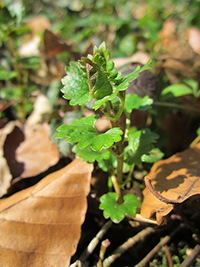Table of Contents
The ground ivy plant has been used as a medicinal herb since the Middle Ages. Saint Hildegard, the German abbess of the order of St. Benedict, recommended this plant for respiratory conditions.
- Step into the enchanting world of Health Embassy’s Ground Ivy Herb Tea. 🍀 Whether enjoyed on its own or blended harmoniously with complementary herbs and natural sweeteners, it promises an unforgettable journey of herbal delights.
- Unleash your creativity with Health Embassy’s Ground Ivy Herb Tea, as its versatility allows you to experiment with a myriad of ingredients, crafting unique blends tailored to your individual taste preferences. 🍀
- Expand your tea collection with the distinctive flavor profile of Ground Ivy Herb, offering a refreshing and invigorating addition to your herbal repertoire. 🍀
- Elevate your tea rituals by infusing Health Embassy’s Ground Ivy Herb Tea with herbs like peppermint for a burst of freshness, lavender for a soothing aroma, or lemon balm for a citrusy twist. 🍀 Explore the realm of natural sweeteners such as stevia, honey, or coconut sugar to enhance its flavor profile.
- Embark on an exciting journey of exploration with Health Embassy’s Ground Ivy Herb Tea, a botanical treasure waiting to be discovered. 🍀

Healing Properties and Indications
The whole plant contains the bitter ingredients choline, phenolic acids, and tannin. It has expectorant and pectoral properties. Internal use is recommended for bronchial catarrh and chronic bronchitis, easing the expulsion of secretions and reducing the congestion of the respiratory system. It also renders good results with bronchial asthma. External use is recommended to treat wounds and hemorrhoids due to their vulnerary properties.
Ground Ivy Plant Scientific Facts

- Other names: Alehoof, cat’s paw, creeping Charlie, grill-over-the-ground, gillrun, hay maids, hedge maids, turnhoof.
- French: Lierre Terrestre.
- Spanish: Hiedra Terrestre.
- Environment: Humid soil, prairies, and bushes of Europe and America.
- Description: Vivacious plant of the Labiatae family, with ground stems, branches growing to 25 cm high, and violet, pink, or white flowers.
- Parts of the plant used medicinally: The flower clusters.

How to use Ground Ivy
- Infusion with 20-30 g of flower clusters per liter of water, drinking three or four hot cups a day, sweetened with honey.
- Fresh juice of the whole plant: a spoonful, three times a day.
- Compresses soaked in a decoction of 60 g of plant per liter of water are applied to wounds and hemorrhoids.
Frequently Asked Question
What are the most well-supported benefits of ground ivy?
Antioxidant and anti-inflammatory effects: Ground ivy contains compounds (primarily rosmarinic acid) that exhibit these properties. Studies demonstrate the potential for reducing cellular damage and inflammation associated with various health conditions.
Respiratory support: It has traditionally been used as an expectorant for coughs, bronchitis, and congestion. Some evidence suggests this is due to its ability to thin mucus and relax airways.
Can ground ivy aid in wound healing?
While traditionally used for this purpose, there is limited scientific research in this area. While its astringent properties may assist in drying fluids, more study is necessary on its effectiveness in wound healing.
Are there potential anticancer effects associated with ground ivy?
Laboratory studies show some promise, but human research is minimal. Certain compounds in ground ivy display activity against cancer cell lines in lab environments, but this doesn’t directly translate to cancer treatment in humans.
How is ground ivy typically used for health purposes?
Common preparations include:
1. Tea infusions from dried leaves
2. Tinctures (alcohol extracts)
3. Capsules with powdered ground ivy
4. Historical topical usage for skin conditions (less common now)
Does ground ivy have diuretic properties?
It has been traditionally used as a mild diuretic, helping increase urine output. Some evidence supports this, but more research is needed to determine its effectiveness compared to established diuretics.
Are there any known adverse side effects of ground ivy?
Generally considered safe in moderation. Some potential side effects:
1. Stomach upset or diarrhea in sensitive individuals
2. Possible interactions with blood thinners due to vitamin K content (consult a doctor)
Can I take ground ivy while pregnant or breastfeeding?
Not recommended. Safety hasn’t been established for these populations, so avoiding it is best.
Does ground ivy interact with any medications?
Potential for interaction with blood thinners. Consult your doctor before taking ground ivy if you’re on any medication.
What part of the ground ivy plant is used?
The aerial parts (leaves and stems) are primarily used for their medicinal properties.
Where can I find reliable information and resources about ground ivy?
Websites like the National Center for Complementary and Integrative Health (NCCIH) https://www.nccih.nih.gov/
Reputable herbal medicine resources, e.g., https://www.eatweeds.co.uk/.
Consult a doctor or licensed herbalist for personalized advice.
DISCLAIMER: All content on this website is presented solely for educational and informational objectives. Do not rely on the information provided as a replacement for advice, diagnosis, or treatment from a qualified medical expert. If you are pregnant, nursing, or have any preexisting medical concerns, talk to your doctor before using any herbal or natural medicines.
REFERENCES
- George D. Pamplona-Roger, M.D. “Encyclopedia of Medicinal Plants.” George D. Pamplona-Roger, M.D. Encyclopedia of Medicinal Plants. Ed. Francesc X. Gelabert. Vols. 1 San Fernando de Henares: Editorial Safeliz, 2000. 307. Print.
- https://www.ncbi.nlm.nih.gov/pmc/articles/PMC8949430/
- https://www.eatweeds.co.uk/ground-ivy-glechoma-hederacea
- https://www.rxlist.com/supplements/ground_ivy.htm
- https://www.webmd.com/vitamins/ai/ingredientmono-26/ground-ivy
Last update on 2024-07-21 / Affiliate links / Images from Amazon Product Advertising API





